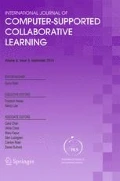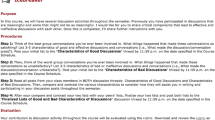Abstract
This paper introduces an approach to analyzing temporal patterns of knowledge construction (KC) in online discussions, including consequences of role assignments. The paper illustrates the power of this approach for illuminating collaborative processes using data from a semester-long series of discussions in which 21 university students were assigned weekly roles. The KC contributions of all 252 posts in the discussion were coded using a five phase scheme (Gunawardena et al. 1997). Then, statistical discourse analysis was applied to identify segments of discussion characterized by particular aspects of KC, and “pivotal posts”—those posts which initiated new segments of discussion. Finally, the influences of assigned student roles on pivotal posts and KC were modeled. The results indicate that most online discussions had a single pivotal post separating the discussion into two distinct segments: the first dominated by a lower KC phase; the second dominated by a higher KC phase. This provides empirical evidence supporting the progressive nature of the KC process, but not the necessity of the full five-phase sequence. The pivotal posts that initiated later segments were often contributed mid-discussion by students playing one of two summarizing roles (Synthesizer and Wrapper). This suggests that assigning a summarizing role mid-discussion can aid group progress to more advanced phases of KC. Finally, in some discussion segments, the KC phase of a post was related to characteristics of the two preceding posts. Collectively, the results demonstrate the power of this temporal approach for investigating interdependencies in collaborative KC in online discussions.




Similar content being viewed by others
References
Benjamini, Y., Krieger, A. M., & Yekutieli, D. (2006). Adaptive linear step-up procedures that control the false discovery rate. Biometrika, 93, 491–507.
Bryk, A. S., & Raudenbush, S. W. (1992). Hierarchical linear models. London: Sage.
Chiu, M. M. (2008a). Flowing toward correct contributions during groups’ mathematics problem solving: A statistical discourse analysis. Journal of the Learning Sciences, 17(3), 415–463.
Chiu, M. M. (2008b). Creating new ideas during argumentation. Contemporary Educational Psychology, 33, 383–402.
Chiu, M. M., & Khoo, L. (2003). Rudeness and status effects during group problem solving. Journal of Educational Psychology, 95, 506–523.
Chiu, M. M., & Khoo, L. (2005). A new method for analyzing sequential processes: Dynamic multi-level analysis. Small Group Research, 36, 600–631.
Cohen, J., West, S. G., Aiken, L., & Cohen, P. (2003). Applied multiple regression/correlation analysis for the behavioral sciences. Mahwah: Lawrence Erlbaum.
Cress, U. (2008). The need for considering multilevel analysis in CSCL research: An appeal for the use of more advanced statistical methods. International Journal of Computer-Supported Collaborative Learning, 3(1), 69–84.
Dansereau, D. F. (1988). Cooperative learning strategies. In C. E. Weinstein, E. T. Goetz, & P. A. Alexander (Eds.), Learning and study strategies: Issues in assessment, instruction, and evaluation (pp. 103–120). Orlando: Academic.
De Wever, B., Schellens, T., Valcke, M., & Van Keer, H. (2006). Content analysis schemes to analyze transcripts of online asynchronous discussion groups: A review. Computers & Education, 46, 6–28.
De Wever, B., Van Keer, H., Schellens, T., & Valcke, M. (2007). Applying multilevel modeling to content analysis data: Methodological issues in the study of role assignment in asynchronous discussion groups. Learning and Instruction, 17(4), 436–447.
De Wever, B., Schellens, T., Van Keer, H., & Valcke, M. (2008). Structuring asynchronous discussion groups by introducing roles: Do students act up to the assigned roles? Small Group Research, 39, 770–794.
De Wever, B., Van Keer, H., Schellens, T., & Valcke, M. (2010). Roles as structuring tool in online discussion groups: The differential impact of different roles on social knowledge construction. Computers in Human Behavior, 26(4), 516–523.
Dillenbourg, P. (1999). What do you mean by collaborative learning? In P. Dillenbourg (Ed.), Collaborative-learning: Cognitive and computational approaches (pp. 1–19). Oxford: Elsevier.
Dillenbourg, P., & Jermann, P. (2007). Designing integrative scripts. In F. Fischer, H. Mandl, J. Haake, & I. Kollar (Eds.), Scripting computer-supported collaborative learning: Cognitive, computational, and educational perspectives (pp. 275–295). New York: Springer.
Goldstein, H. (1995). Multilevel statistical models. Sydney: Edward Arnold.
Gunawardena, C. N., Lowe, C. A., & Anderson, T. (1997). Analysis of a global online debate and the development of an interaction analysis model for examining social construction of knowledge in computer conferencing. Journal of Educational Computing Research, 17(4), 397–431.
Guzdial, M., & Turns, J. (2000). Effective discussion through a computer-mediated anchored forum. Journal of the Learning Sciences, 9(4), 437–469.
Haake, J. M., & Pfister, H. R. (2007). Flexible scripting in net-based learning groups. In F. Fischer, I. Kollar, H. Mandl, & J. M. Haake (Eds.), Scripting computer-supported cooperative learning: Cognitive, computational, and educational perspectives (pp. 155–175). New York: Springer.
Hara, N., Bonk, C. J., & Angeli, C. (2000). Content analyses of on-line discussion in an applied educational psychology course. Instructional Science, 28(2), 115–152.
Herring, S. (1999). Interactional coherence in CMC. Journal of Computer-Mediated Communication, 4(4). doi:10.1111/j.1083-6101.1999.tb00106.x.
Johnson, D. W., & Johnson, R. T. (1992). Positive interdependence: Key to effective cooperation. In R. Hertz-Lazarowitz & N. Miller (Eds.), Interaction in cooperative groups: The theoretical anatomy of group learning (pp. 174–199). New York: Cambridge University Press.
Kauffeld, S., & Meyers, R. A. (2009). Complaint and solution-oriented circles: Interaction patterns in work group discussions. European Journal of Work and Organizational Psychology, 18, 267–294.
Kennedy, P. (2004). A guide to econometrics. Cambridge: Blackwell.
King, A. (1997). ASK to THINK – TEL WHY®©: A model of transactive peer tutoring for scaffolding higher level complex learning. Educational Psychologist, 32(4), 221–235.
King, A. (2007). Scripting collaborative learning processes: A cognitive perspective. In F. Fischer, I. Kollar, H. Mandl, & J. Haake (Eds.), Scripting computer supported communication of knowledge: Cognitive, computational and educational perspectives (pp. 13–37). New York: Springer.
Krippendorff, K. (2004). Content analysis: An introduction to its methodology (2nd ed.). Thousand Oaks: Sage.
Krull, J. L., & MacKinnon, D. P. (2001). Multilevel modeling of individual and group level mediated effects. Multivariate Behavioral Research, 36, 249–277.
Lally, V. (2001). Analysing teaching and learning interactions in a networked collaborative learning environment: Issues and work in progress. In Euro CSCL 2001 (pp. 397–405). Maastricht McLuhan Institute.
Lemke, J. L. (2000). Across the scales of time: Artifacts, activities, and meanings in ecosocial systems. Mind Culture and Activity, 7(4), 273–290.
Lund, K., Law, N., Rosé, C., Suthers, D., & Teplovs, C. (2009). Pinpointing pivotal moments in collaboration. Workshop held at the STELLARnet Alpine Rendez-Vous, Garmisch-Partenkirchen Germany.
Marra, R. M., Moore, J. L., & Klimczak, A. K. (2004). Content analysis of online discussion forums: A comparative analysis of protocols. Educational Technology Research and Development, 52, 23–40.
Mercer, N. (2008). The seeds of time. Journal of the Learning Sciences, 17, 33–59.
O’Donnell, A. M., & Dansereau, D. F. (1992). Scripted cooperation in student dyads: A method for analyzing and enhancing academic learning and performance. In R. Hertz-Lazarowitz & N. Miller (Eds.), Interaction in cooperative groups: The theoretical anatomy of group learning (pp. 120–141). London: Cambridge University Press.
Paavola, S., Lipponen, L., & Hakkarainen, K. (2004). Models of innovative knowledge communities and three metaphors of learning. Review of Educational Research, 74, 557–576.
Palinscar, A. S., & Brown, A. L. (1984). Reciprocal teaching of comprehension-fostering and comprehension monitoring activities. Cognition and Instruction, 1(2), 117–175.
Pena-Shaff, J. B., & Nicholls, C. (2004). Analyzing student interactions and meaning construction in computer bulletin board discussions. Computers & Education, 42, 243–265.
Persell, C. H. (2004). Using focused web-based discussion to enhance student engagement and deep understanding. Teaching Sociology, 32, 61–78.
Piaget, J. (1985). Equilibration of cognitive structures: The central problem of cognitive development. Chicago: University of Chicago Press.
Reimann, P. (2009). Time is precious: Variable- and event-centered approaches to process analysis in CSCL research. International Journal of Computer Supported Collaborative Learning, 4(3), 239–257.
Reyes P., & Tchounikine, P. (2003). Supporting emergence of threaded learning conversations through augmenting interactional and sequential coherence. Proceedings of the International Conference on Computer Supported Collaborative Learning, CSCL’2003, Bergen (Norway), 83–92.
Rourke, L., Anderson, T., Garrison, D. R., & Archer, W. (2001). Assessing social presence in asynchronous text-based computer conferencing. Journal of Distance Education, 14(3), 51–70.
Schellens, T., Van Keer, H., & Valcke, M. (2005). The impact of role assignment on knowledge construction in asynchronous discussion groups: A multilevel analysis. Small Group Research, 36(6), 704–745.
Schellens, T., Van Keer, H., De Wever, B., & Valcke, M. (2007). Scripting by assigning roles: Does it improve knowledge construction in asynchronous discussion groups? International Journal of Computer-Supported Collaborative Learning, 2(2/3), 225–246.
Seo, K. K. (2007). Utilizing peer moderating in online discussions: Addressing the controversy between teacher moderation and nonmoderation. American Journal of Distance Education, 21(1), 21–36.
Sheskin, D. J. (1997). Parametric and nonparametric statistical procedures. CRC Press.
Stahl, G., & Rosé, C. P. (2011). Group cognition in online groups. In: E. Salas & S. M. Fiore (Eds.), Theories of team cognition: Cross-disciplinary perspectives. Routledge/Taylor & Francis.
Strijbos, J. W., Martens, R. L., Jochems, W. M. G., & Broers, N. J. (2004). The effect of functional roles on group efficiency: Using multilevel modeling and content analysis to investigate computer-supported collaboration in small groups. Small Group Research, 35, 195–229.
Tagg, A. C. (1994). Leadership from within: Student moderation of computer conferences. American Journal of Distance Education, 8(3), 40–50.
Thomas, M. J. W. (2002). Learning within incoherent structures: The space of online discussion forums. Journal of Computer Assisted Learning, 18, 351–366.
Veerman, A., & Veldhuis-Diermanse, E. (2001). Collaborative learning through computer-mediated communication in academic education. In Euro CSCL 2001 (pp. 625–632). Maastricht: McLuhan institute, University of Maastricht.
Wee, J. D., & Looi, C. K. (2007). Model for analysing collaborative knowledge construction in a quasi-synchronous chat environment. Paper presented at the International Conference on Computer-Supported Collaborative Learning, Chat Analysis Workshop, New Brunswick, NJ.
Weinberger, A., & Fischer, F. (2006). A framework to analyze argumentative knowledge construction in computer-supported collaborative learning. Computers & Education, 46, 71–95.
Wise, A. F., Padmanabhan, P., & Saghafian, M. (2010a). Exploring learners’ enactment experiences of functionally-specific assigned roles in online discussions. Paper presented at the Annual Meeting of the American Education Research Association, Denver, CO.
Wise, A. F., Saghafian, M., & Padmanabhan, P. (2010b). ASIMeC-F: A content analysis scheme for assessing the presence of conversational functions in asynchronous discussions. Paper presented at the Annual Meeting of the American Education Research Association, Denver, CO.
Wise, A. F., Saghafian, M., & Padmanabhan, P. (2011). Towards more precise design guidance. Specifying and testing the functions of assigned student roles in online discussions. Submitted for publication.
Xin, M. C., Glass, G., Feenberg, A., Bures, E. M., & Abrami, P. (2011). From active reading to active dialogue. In F. Pozzi & D. Persico (Eds.), Techniques for fostering collaboration in online learning communities: Theoretical and practical perspectives (pp. 300–318). Hershey: IGI Global Publishing.
Yang, Y., Newby, T. J., & Bill, R. L. (2005). Using Socratic questioning to promote critical thinking skills through asynchronous discussion forums in distance learning environments. American Journal of Distance Education., 19(3), 163–181.
Zhu, P. (1998). Learning and mentoring: Electronic discussion in a distance learning course. In C. J. Bonk & K. S. King (Eds.), Electronic collaborators: Learner-centered technologies for literacy, apprenticeship, and discourse (pp. 233–259). Mahwah: Erlbaum.
Author information
Authors and Affiliations
Corresponding author
Additional information
This work emerged from a workshop which was partially financed by the European STELLAR Network of Excellence (FP7).
Electronic Supplementary Material
Below is the link to the electronic supplementary material.
Supplementary 1
(PDF 114 kb)
Rights and permissions
About this article
Cite this article
Wise, A.F., Chiu, M.M. Analyzing temporal patterns of knowledge construction in a role-based online discussion. Computer Supported Learning 6, 445–470 (2011). https://doi.org/10.1007/s11412-011-9120-1
Received:
Accepted:
Published:
Issue Date:
DOI: https://doi.org/10.1007/s11412-011-9120-1




